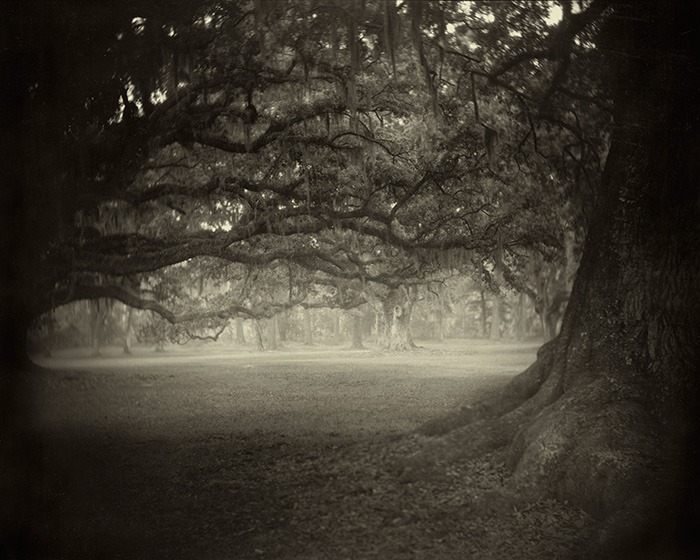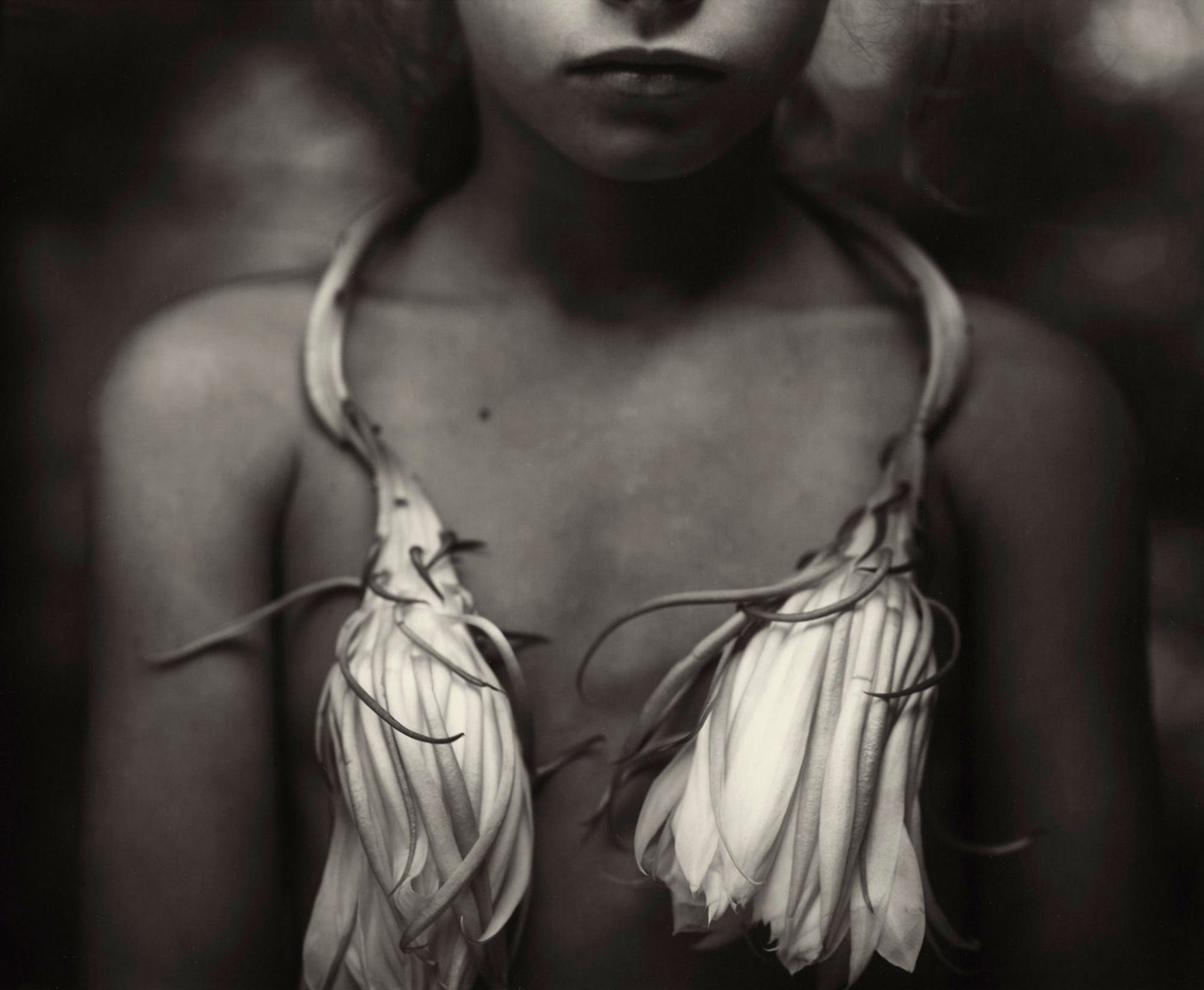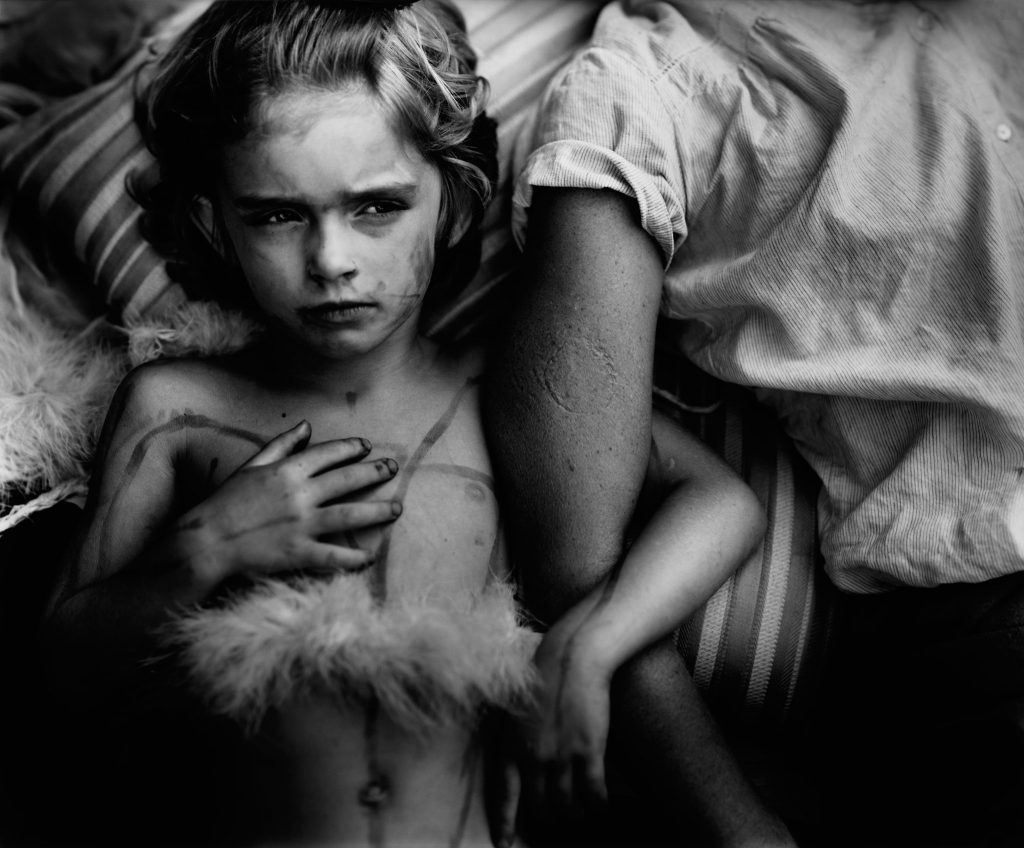In her memoir, released in May, 2015, Sally Mann reveals an intimate, visceral, and beautiful family history, steeped in the gritty landscape of the American South.
Combining startling photographs with narrative prose, the author captivates readers by piecing together artifacts from her ancestors and their surroundings.
Hold Still: A Memoir With Photographs was a National Book Award finalist and named one of the best books of the year by The New York Times, Publishers Weekly, and others.

Born in 1951 in Virginia, Sally Mann was the only daughter but the third child for Robert and Elizabeth Munger. Her father was a doctor while her mother worked in a Washington and Lee University bookstore.

Sally began her career in photography by using her father’s old 5” by 7” camera. She continued with formal coursework in photography at the Putney Boarding School in Vermont.
She showed some of her student photographs at Putney before she graduated in 1969. Sally took art and photography classes at Bennington College, Friends World College and earned her B.A. and an MFA from Hollins University.

Original prints of Sally Mann’s photographs can run between five and six figures at auction, such as this signed and numbered gelatin silver print of Candy Cigarette, which was estimated between $80,000 to $120,000, and ended up selling for $257,000.
Second Sight
Sally Mann has always stayed faithful to her southern roots, Shenandoah Valley and the rolling hills in Rockbridge County. She has always photographed primarily in the southern areas of the United States.
She returned to Virginia after graduation where she worked as a photographer at Washington and Lee. Her photographs of the building process of Lewis Hall, the new law building, led to Sally’s first solo show at the Corcoran Gallery of Art, Washington, D.C. in 1977. These somewhat surrealistic images later were included in Second Sight, her first publication in 1983.
Although her work has often been called controversial, she attracts a wide, varied audience of people and always remains influential.
At Twelve
When Sally published At Twelve: Portraits of Young Women in 1988, she showed the world her visual study of adolescent girls which stirred up many conversations and questions.

She felt that she had captured some of the typical preteen emotions to portray the developing identities of young girls. Her use of an interesting and unusual printing style brought a brooding and dramatic mood to her images.
Immediate Family
Perhaps Mann is best known for her third publication from 1992, Immediate Family, a series that features her three children. This book contains sixty-five photographs of her children when they were all less than ten years old.
The remote setting for many of the pictures was around the family’s cabin near a river where they spent time in the summers. Her children are shown nude while playing and swimming.

Many of the photographs show typical childhood activities such as reading the newspaper funnies, playing dress up, vamping, sleeping and playing board games as well as skinny dipping.
But some seem to suggest and explore darker themes such as loneliness, insecurity, sexuality, injury and death.
Newspapers and magazines eagerly covered this new publication.

The New York Times stated that probably no other photographer in the country’s history had enjoyed such a public rush of success in today’s art world. Photos by Sally Mann have appeared on its cover at least twice: first in 1992, a picture of the three children for a feature article covering her so called disturbing work and again in September 2001, a self-portrait including her two young daughters for the theme issue titled “Women Looking at Women.”
Controversy over Immediate Family intensified. In America and in Europe, accusations of child pornography were bandied about in hushed conversations.
The Wall Street Journal censored an image of Mann’s four year old daughter, Virginia. Yet Mann said that she considered the photographs of her children to be completely natural in her own eyes as their mother.
Some critics agreed and accepted her explanation as accurate since it was from her point of view. Some said they were relieved to see a portrayal other than the too familiar versions of youth shown as sweetness, light and innocence.
The book was described as showing a place that must resemble the Garden of Eden cast in the shifting and subdued lights and shadows of sexuality, nostalgia and death.
In 2001, when Time magazine called Sally Mann America’s best photographer, the paper wrote that Mann had successfully captured a combination of carefully staged and spontaneous childhood moments.
The degree of repose and sometimes unnerving imaginative play seemed carefully coached. But the critics overlooked the patient devotion of this project and the cooperation of her children. The question arose: Were the young subjects being taken advantage of or manipulated?
As a collection of family photographs, not one other is remotely like it. The New Republic ranked Mann’s Immediate Family as one of the greatest books about photography to be created in our time.

Still Time
Mann’s fourth book, Still Time, was published in 1994. This one was based on her traveling exhibition which included over twenty years of photography as well as earlier landscapes printed with color and some abstract photographs.
During the middle of the 1990s, Mann started photographing landscapes onto 8” x 10” wet plate collodion glass negatives, using an ancient 8” x 10” bellows camera.
This photographic process was first developed in the 1850s by the pioneers of modern photography. These landscapes first were included in Still Time and then later featured in two different shows at the NYC Edwynn Houk Gallery: Sally Mann – Mother Land: Recent Landscapes of Georgia and Virginia, 1997 and Deep South: Landscapes of Louisiana and Mississippi, 1999. The time consuming process produced an image that was indistinct, swirling and sometimes called ethereal due to its characteristic painterly patina finish.
Sally shoots her images with antique cameras dating from the early 1900s. These cameras are the kind of large set-ups that require the photographer to duck under a dark cloth when it is time to take a picture.
These antiques have bulky, hulking wooden frameworks, bellows that are like accordion bellows and old brass lenses, often moldy inside, usually held together with pieces of tape. She says that she prefers this old equipment since it makes the light softer which lends a timelessness to the pictures.
Sally Mann says she is not interested in having her images appear to be precise and really sharp; she wants them to appear mysterious.
What Remains
In 2003, the fifth book, What Remains, was published. It was based on a show with the same name held at the Corcoran Gallery, Washington, DC, presented in five parts.
Photographs of the decomposed remains of Sally’s greyhound dog, Eva, make up the first part.
The second section consists of photographs of the decomposing bodies, purposely left to rot as part of a scientific study, in a federal Forensic Anthropology Facility.
A third part shows details of the site on Mann’s property where the killing of an escaped convict took place.
The fourth part showcases the grounds around Antietam, Virginia; site of the single bloodiest one day battle in American history.
The fifth and last part is composed of very close up partial views of her children’s faces enlarged to 3’6” by 4’6” monumental snap shots.
Perhaps we are to consider What Remains a detailed study covering mortality, decay and death that ends in the hope and love of youth?
Deep South
In Mann’s Deep South, her sixth book which was published in 2005, she includes many landscapes created during 1992 to 2004. Sixty-five haunting black and white images describe the landscapes of the southern United States: vine covered hills, battlefields, decaying mansions and sites of bloody skirmishes.
Newsweek magazine selected Deep South as their 2005 holiday gift book choice, and described Mann’s process as walking straight up to each typical Southern stereotype used in her book and subtly demolishing it. She somehow creates incredibly haunting, disturbing images which seem to exist in between documents and dreams where time is slowed down and the feeling of life is stilled.

Proud Flesh
Mann’s seventh book, Proud Flesh, was published in 2009. It is her six year documentary study of the effects of muscular dystrophy on Larry Mann, her husband, who is active as a lawyer and blacksmith. The project was displayed in October 2009 at Gagosian Gallery.
The mysterious quality of the old-time bellows camera image is evident in this intimate series. The shadows and milky lights play over the body of her husband.
Sally said that a good picture often results due to the expense of the person posing. Exploitation may be at the root, even if the sitter is your husband.
But Larry voluntarily made himself vulnerable by posing for her because he believes in her work and, as concerned as Sally was over showing her husband frail and weak, he is not. It’s not hurtful, he said, if it’s a strong, meaningful work. He did comment that when Sally started the Proud Flesh series, she asked if he could be comfortable with it. But as soon as he saw the first images, he knew that they were strong images and it would be a great series.

One of Larry’s favorite roles through the years has been to support Sally, to tell her to just keep moving because the waves of self-doubt often come crashing down on her. Sally says that it is not lack of confidence in herself because she knows that she has produced some good work. But she admits that the raw fear is always that she has taken her last good shot. She says that you do, however, think over your life as an artist when you get nearer to sixty years old, and wonder if this might be the last chapter of the book.
The Flesh and The Spirit
The eighth book, The Flesh and The Spirit, was published in 2010 and released along with the comprehensive showing at the Virginia Museum of Fine Arts, Richmond, Virginia.
The two hundred page book contains early work such as 1970s color Polaroids, platinum prints and unpublished color photos from the 1990s of the children. Also included are new and recent works including landscapes, some unpublished self-portraits, the monumental children’s faces, images of her husband and some of the bodies at the forensic institute. The overall unifying theme is images of the body, its various illnesses and eventual death.
More current projects include a study of slavery in the state of Virginia, a set of self-portraits and some intimate images of her family and their life. The last one, titled Marital Trust, covers thirty years of time and intimate details of family life. Sally shares their 425 acre farm with several dogs and well-loved Arabian horses all fed faithfully every morning by Larry.
Mann is also very passionate about riding, especially endurance type horse racing. In 2006, Mann was riding one of her horses when the animal ruptured an aneurysm. She was thrown violently to the ground and this sudden impact broke her back.
During her two year recovery period, she made a new series of ambrotype self-portraits, one of the old fashioned wet plate processes that she favors. These self-portraits went on view to the public for the very first time in November 2010 as part of Sally Mann: the Flesh and the Spirit held at the Virginia Museum of Fine Arts. Sally is currently represented by the Gagosian Gallery and the Edwynn Houk Gallery which are both in New York City.
Honors & Exhibitions
Sally Mann is recognized as a Guggenheim fellow and was honored to receive the National Endowment for the Arts fellowship three times. She has been the subject of two separate documentaries: Blood Ties in 1994 which was also nominated for an Academy Award and What Remains in 2007 which was premiered at the Sundance Film Festival as well as nominated for an Emmy: Best Documentary in 2008.
The subject of several major exhibitions at the Corcoran Gallery of Art, Washington D.C. and the Institute of Contemporary Art in Philadelphia, PA, her interesting photographs are found in many private and public collections. These include the Museum of Modern Art, the Metropolitan Museum of Art and the Whitney Museum of American Art, all located in New York City.
More of her work can be found in the permanent collections in the Hirshhorn Museum and Sculpture Garden in Washington D.C., The Museum of Fine Arts in Boston, Massachusetts, and the San Francisco Museum of Modern Art.
Further Reading:
The Disturbing Photography of Sally Mann
Sally Mann: The naked and the dead
